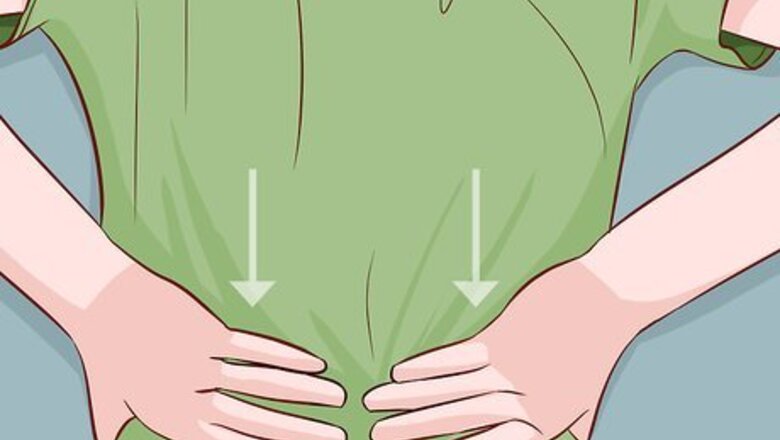
views
Treating Lower Back Pain in Others

Massage the muscle connecting the bottom rib to the pelvis. The quadratus lumborum is the muscle that connects your last rib to your pelvis and is one of the major culprits in lower back pain. Stretch the muscle by pressing into the area between the lower rib in the hips and pulling the muscle down towards the hip. Massage the muscle with your other hand by pressing your fingers firmly, but not aggressively, into the muscle and rubbing in circles. Work the muscle for up to 20 minutes on each side to release tension. This muscle can tighten from engaging the muscles in the lower body while the upper body remains still. For example, this could happen when lifting groceries out of a car trunk, doing dishes while leaning over a sink, or slumping in an office chair.

Work the muscles at the back of the hips. To find the back hip muscle, feel around the area where a pair of pants would sit on the hips. The muscle spreads out over much of the hips, so feel around until you find a spot that seems full of tension. Press firmly into the soft tissue and rub in circles until you feel a release. This muscle is called the gluteus medius and often seems too low to cause lower back pain. However, back pain sufferers often report relief after 20 minutes of massage focused on this muscle.
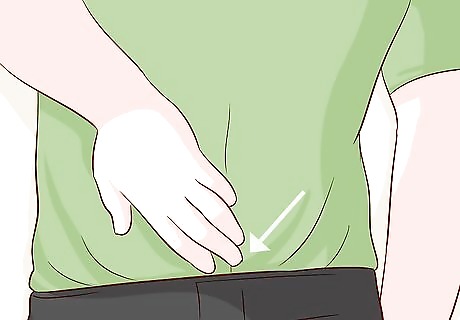
Locate the lower back dimples and press on the muscle 1 centimetre (0.39 in) below. To find a pressure point that can help relieve deep, aching lower back pain, look for dimples near where the back meets the buttocks. If you can't see any visible dimples, apply light pressure around where you think they should be until you feel a bump of bone on the extreme lower back. Rub your fingers back and forth underneath the back dimple until you feel a thick muscle angled away from the dimple. This is the edge of the gluteus maximus. The dimples are usually around 1 to 2 inches (2.5 to 5.1 cm) on either side of the spine.

Push the muscle towards the tail bone. Use a rolling movement to push the muscle towards the tail bone. Press from the side of the muscle towards the spine. Use a pressure that feels good. Rub the area for around 5-10 minutes. Avoid applying too much pressure. Although people suffering from lower back pain might request a lot of pressure, being too aggressive at the outset can cause damage. Apply a medium amount of pressure over a longer period of time. You can massage the quadratus lumborum, hips, and gluteus maximus all in the same session.
Self-Massaging Your Lower Back
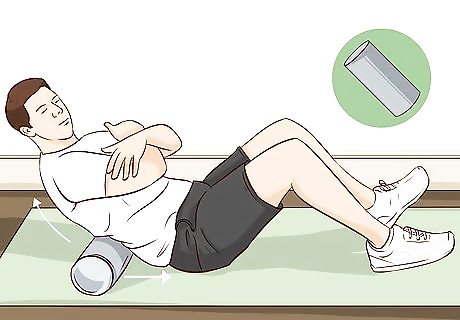
Relieve all-over back pain with a foam roller. While lying on your back, place the foam roller under your shoulders and cross your arms. Press your feet into the ground and lift your hips into the air to put pressure on your shoulders. Gently rock back and forth, so that the roller massages from your shoulders to the middle of your back. Continue this motion for up to 5 minutes. Avoid using a foam roller on your lower back, where your spine meets your tailbone. By massaging your mid back, you might relieve tension that causes pain in your lower back. To target lower back muscles specifically, use tennis balls. To find out where your lower back begins, lie flat on the floor. Notice where your spine starts to curve away from the floor. This is where the lower back begins.

Use a tennis ball to dig into a knot in your lower back. Lie on your back and place the tennis ball underneath you where you are experiencing pain. Gently rock back and forth to massage the area until you feel the tension relax. Rub for 30 seconds to 5 minutes. Lacrosse balls are even better for self-massage, if you have one handy. Avoid placing massage balls directly onto bone or spine. Instead, target the area to either side of the spine and above the hips.
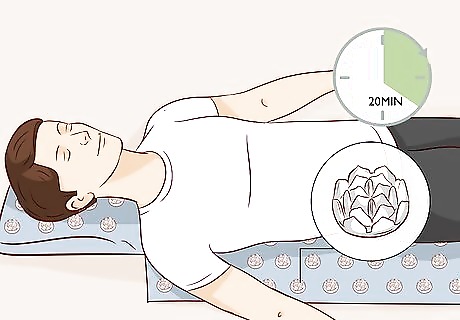
Lie on an acupressure mat for 20 minutes. An acupressure mat simulates the experience of acupuncture without actually piercing your skin. It stimulates blood flow to your muscles and could promote healing. Place the mat on a flat surface, sit with the base of your spine at the edge of the mat, and then roll down onto the mat. The sensation of an acupressure mat can be intense at first. Try lying on it for a few minutes, or as long as you can tolerate, and working up to 20 minutes. Try lying on an acupressure mat on a couch or a bed to put less pressure on your skin.

Use a handheld massager to apply heat and vibration to your back. A wand massager can help you reach your lower back and apply enough pressure to release tension. Place the massager where you feel tension and apply a firm but gentle pressure. Rub back and forth for 30 seconds to 5 minutes. Rub strongly enough to cause a satisfying sensation, but don't apply so much pressure that you damage your muscles. Using a massager for 15 minutes in the same area can cause muscle damage. Muscle damage will feel like a strain and may leave you with stiff or limited movement. It will go away on its own in a few days.
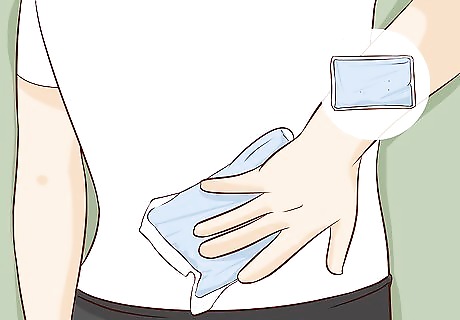
Apply heat or cold to your lower back. Use cold to treat an injury right after it happens. Within 24-48 hours after hurting your lower back or right when you start to feel pain coming on, use ice to numb the area. If you've been feeling pain for longer than 2 days, use a heating pad to stimulate blood flow to your lower back. You can also apply ice 48 hours after you feel pain coming on, if you prefer it. However, do not apply heat within 48 hours of injuring your back, as this can make inflammation worse.
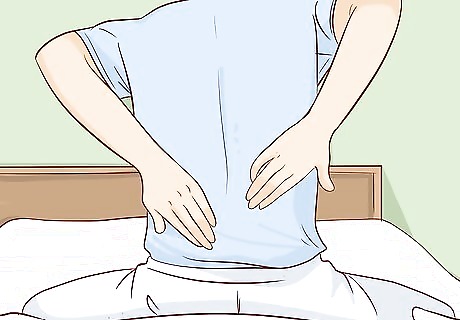
Treat your back before going to bed. Massaging your back, especially by yourself, can actually cause your muscles to feel even more sensitive when you're done. It can take several hours for your muscles to relax. That's when you'll start to feel better. Taking a shower and going to bed right after massaging your own back can help your muscles recover faster and minimize your sensitivity.
Minimizing Lower Back Pain
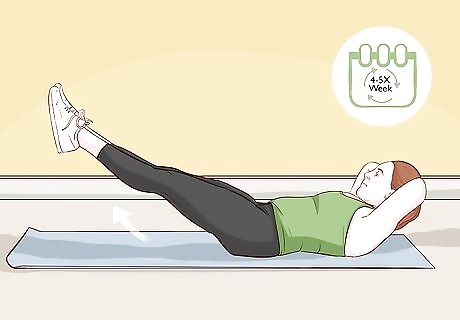
Exercise 4-5 times a week to strengthen your muscles. Moving your body is the most important thing you can do for your back. Building up core muscles and keeping your joints limber can help relieve lower back pain over time. Focus on stretching and doing body weight exercises 3-4 days a week to build up muscle. Do cardio at least 1-2 days a week. To add in cardio, try swimming, especially when your back hurts a lot. You can also try biking or running when your back is feeling better. Aim for each exercise session to last around 20-30 minutes. Try to do just a little bit of exercise, even if your back hurts. Some movement is better than no movement. Combine exercise with physical therapy or massage to get the best results.

Do curl ups or partial crunches to strengthen your core. Start by lying on your back with your arms crossed over your chest. Keep your knees bent. Use your core to lift your back up off of the floor until you can touch your elbows to your knees. Alternatively, place your arms behind your head and raise your shoulders from the floor. Do 8-12 repetitions. Don't focus on doing curl ups too fast or doing too many repetitions at first. Instead, focus on keeping good form.

Try a bird dog stretch to strengthen your back and abdominal muscles. Start on your hands and knees. Then, lift one leg and the opposite arm while keeping your hips level. Hold the position for 5 seconds. Repeat on the other side. Do 8-12 repetitions on each side. If it's too hard to hold your balance, just lift your legs and leave your arms on the ground. For an extra challenge, lengthen your leg behind you each time you lift it.
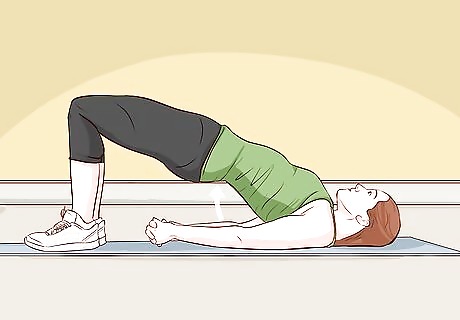
Hold a bridge to strengthen your lower back directly. Lie with your back flat on the floor and your knees bent in front of you. Then, press your heels into the floor and lift your hips into the air to create a straight line from your knees to your neck. Hold the pose for at least 6 seconds. Do 8-12 repetitions. Avoid arching your back by keeping your abdomen tight.
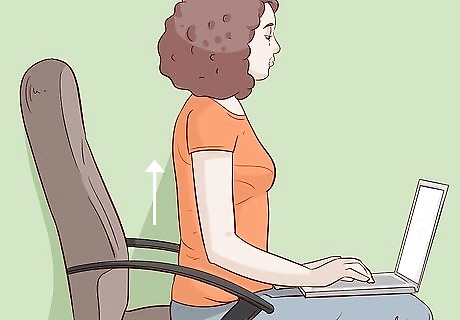
Sit up straight while you are working. If you work in front of a computer or in a desk chair all day, sit up straight and roll your shoulders back. Make sure your weight is evenly distributed between both hips. Try to avoid sitting for longer than 30 minutes at a time. Take a 5-minute break for each 30-minute session. Use a rolled-up towel or a small pillow between your back and the chair to help keep your spine's natural curve supported.
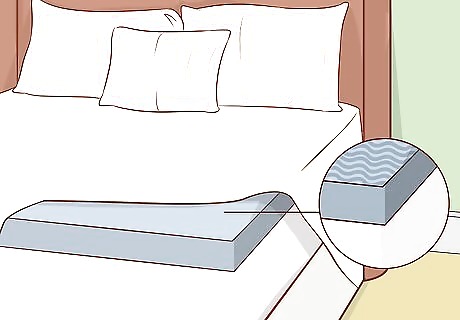
Try adding memory foam bedding if you are a stomach sleeper. Sleeping on your stomach can cause back pain over the years. If you can't stop yourself from sleeping on your back, try sleeping with a memory foam body pillow. This could help your spine stay in a more neutral position while you sleep. You can also try adding a memory foam topper to your bed to help keep your lower back relaxed throughout the night.
See a doctor if you experience chronic back pain that lasts 4-12 weeks. Acute back pain, or pain that lasts for a few days or weeks, will often go away on its own. Pain that lasts longer could be an indication of a more serious problem, although it usually isn't. Getting a medical opinion can help put your mind at ease. Or you can start treatment as soon as possible if there is an underlying reason for your back pain. Your doctor can help come up with a treatment plan that can help relieve lower back pain.




















Comments
0 comment